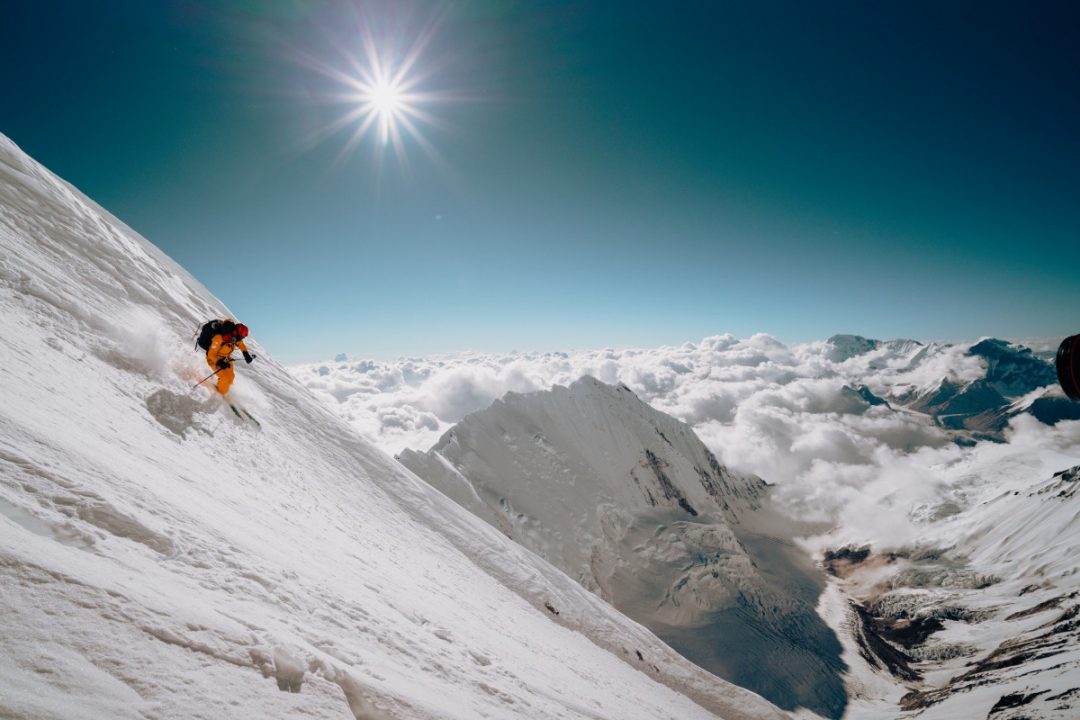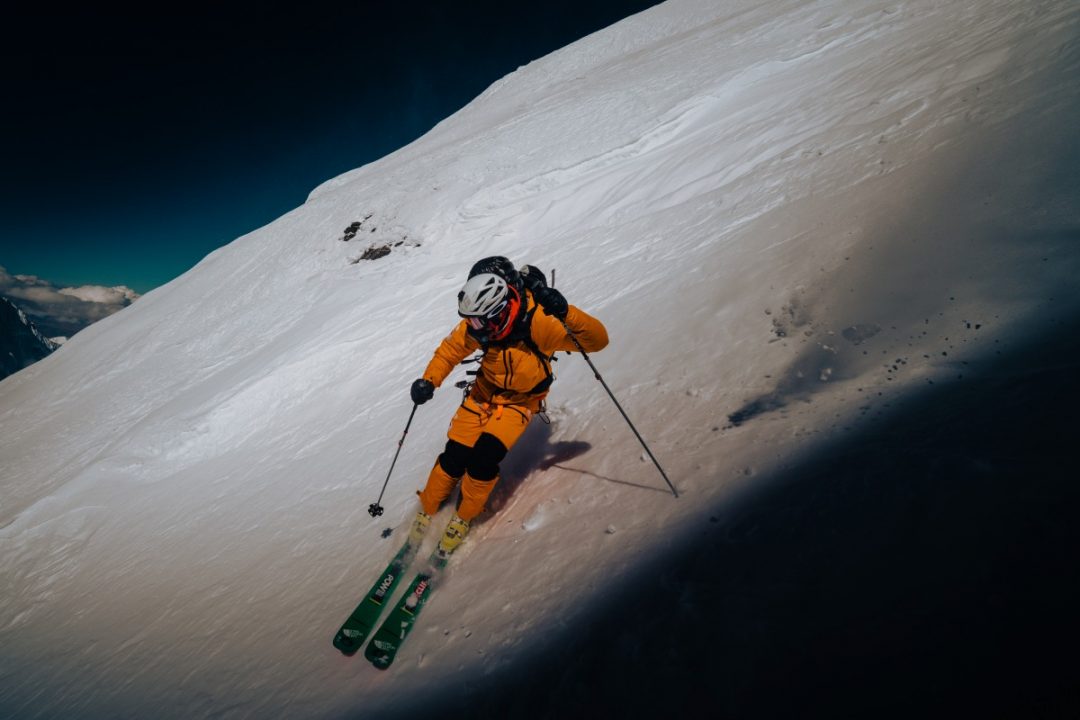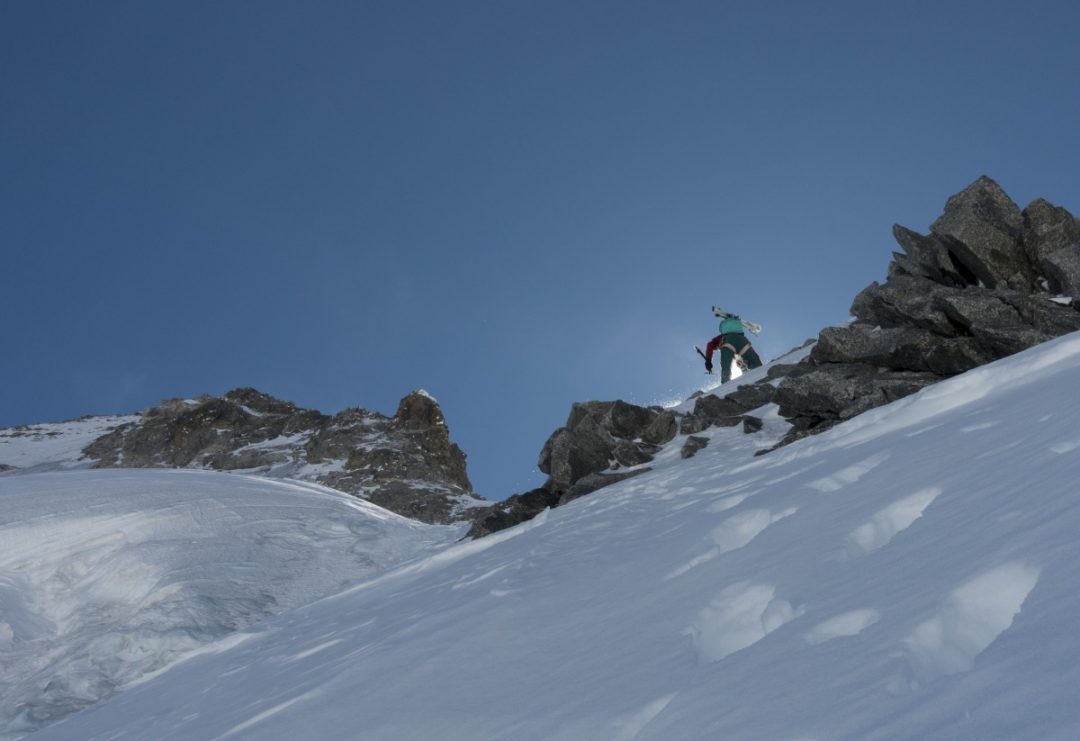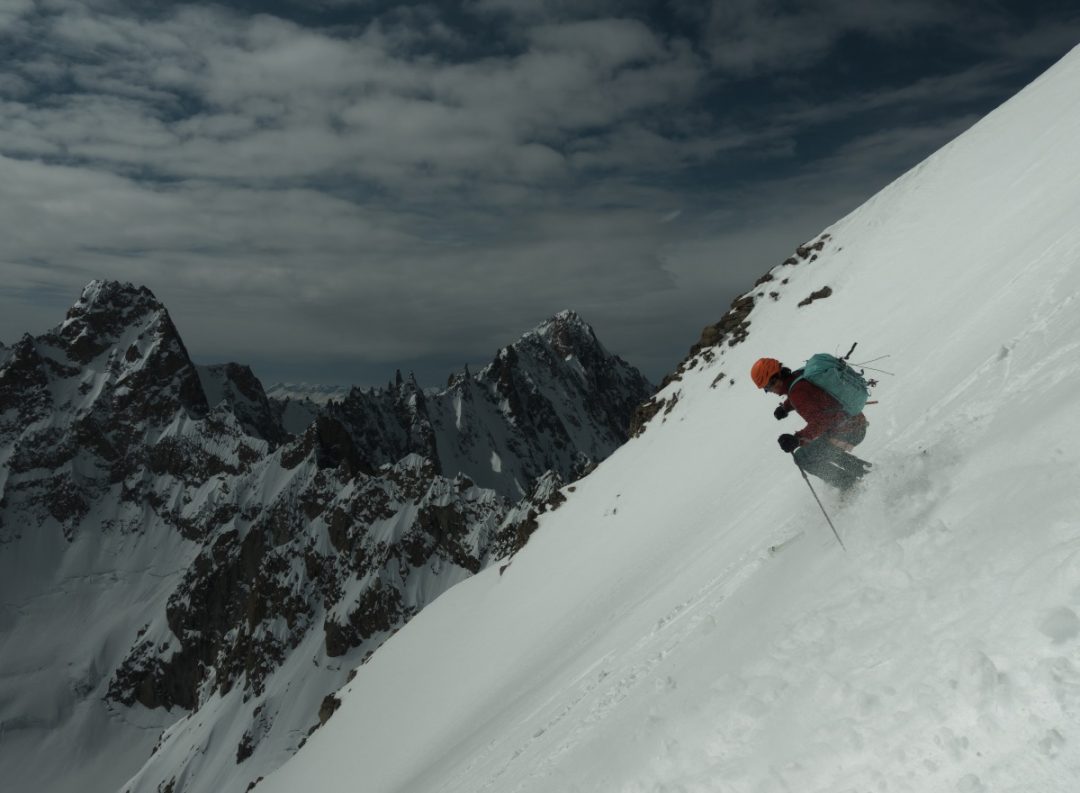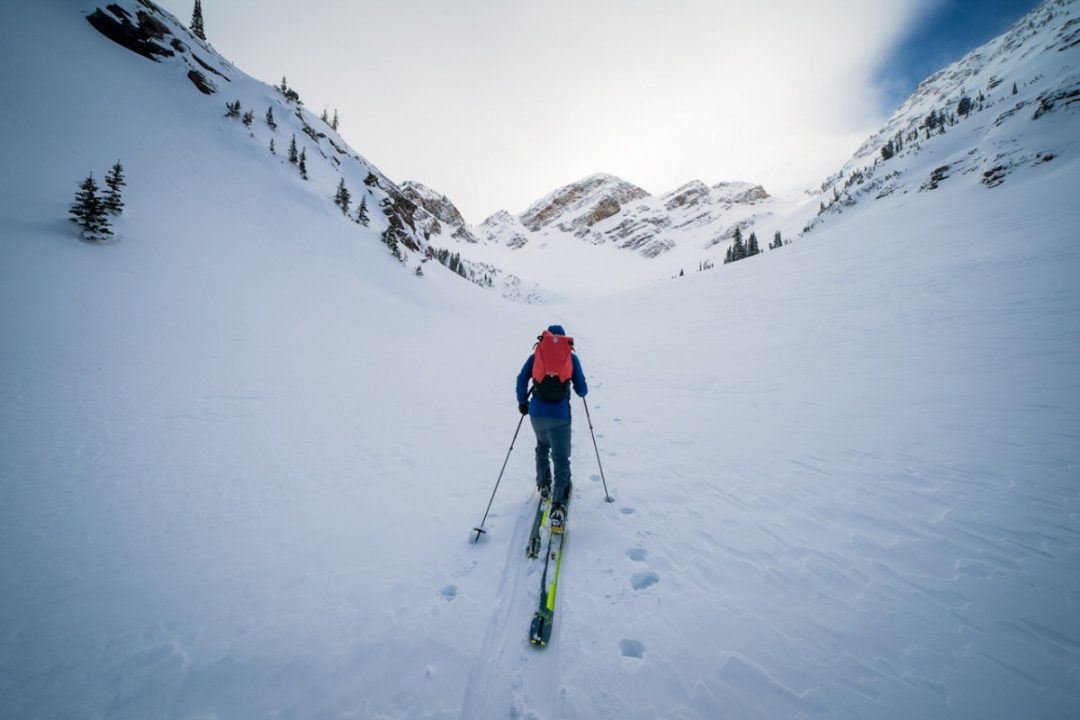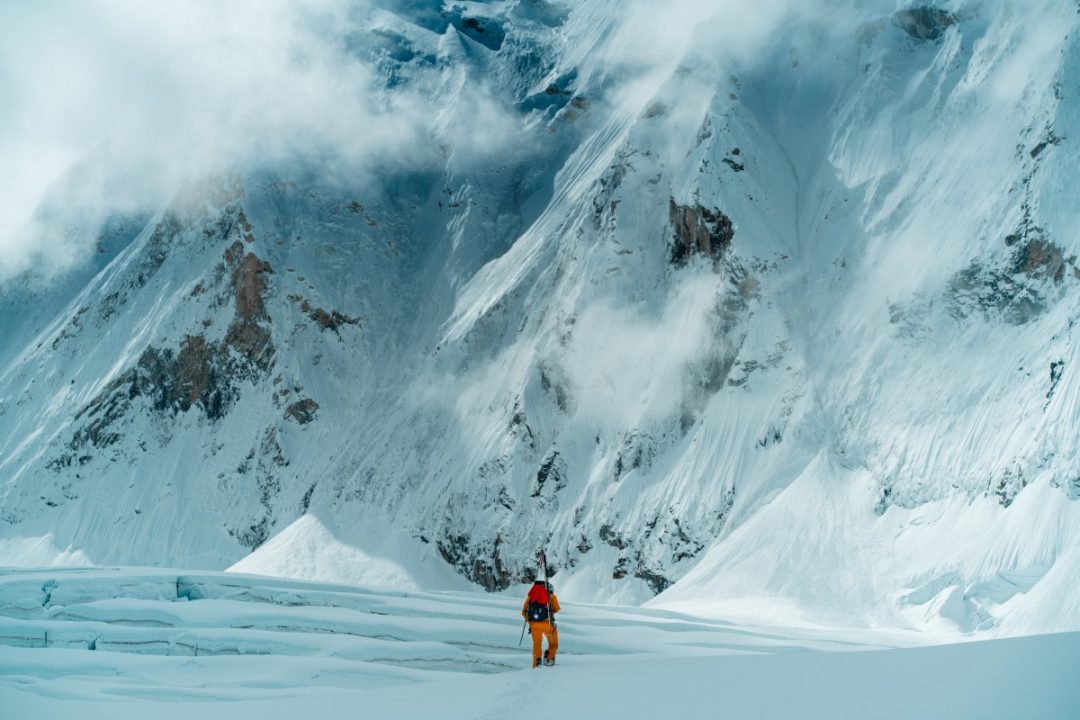This piece is the third and last part of our series on style and ski mountaineering. Despite the likelihood we arrive at a cliff-hanger and do not derive an accepted definition of ski mountaineering or what exactly ski mountaineering might be – we have hopefully evolved the discussion. You can read part one, Lou Dawson’s essay on style, here, and part two, a look into the American Alpine Journal’s reporting on ski mountaineering here.
There’s something called the “threshold test.” The “I know it when I see it,” benchmark for something being this or that; either, or. It’s applied to everything as we navigate the World, define, and then compartmentalize experiences.
In 1964, a Supreme Court Justice popularized the term, “I know it when I see it,” when ruling on a case involving pornography and applying his threshold test.
In the realm of skiing, we’re embracing something less controversial and certainly more granular. In defining what ski mountaineering might be, we, perhaps, also need to understand what it is not.
The journey into this vagueness, which we hope trends towards specificity, began with Brody Leven, a ski mountaineer who sits on an informal ski mountaineering committee at the American Alpine Journal (AAJ). That committee advises Dougald MacDonald, the editor of the AAJ, on what ski descents may be worthy of AAJ inclusion. Part two of this series on style explores the relationship between the AAJ and skiing.
The AAJ is not definitive in the ski world. It is, however, the long-standing journal of record reporting on the World’s sick-nasty alpine climbs. Recently, the AAJ began an earnest effort to highlight significant ski descents annually. So, by logical extension, the third, and last part of the series, digs into how ski mountaineering is defined. If you rap into a ski line, is that ski mountaineering? How about ascending a ridge or face using crampons and axes while tapping into grit and moxie to access an otherwise wide-open bowl you chose not to skin up? Ski mountaineering? Splitting hairs further, what about an all-in ski involving the sharp-pointy-toys, no-fall skiing, a rappel or three, but you’ve got five bar 5G service and you’re near-live IG posting the adventure?
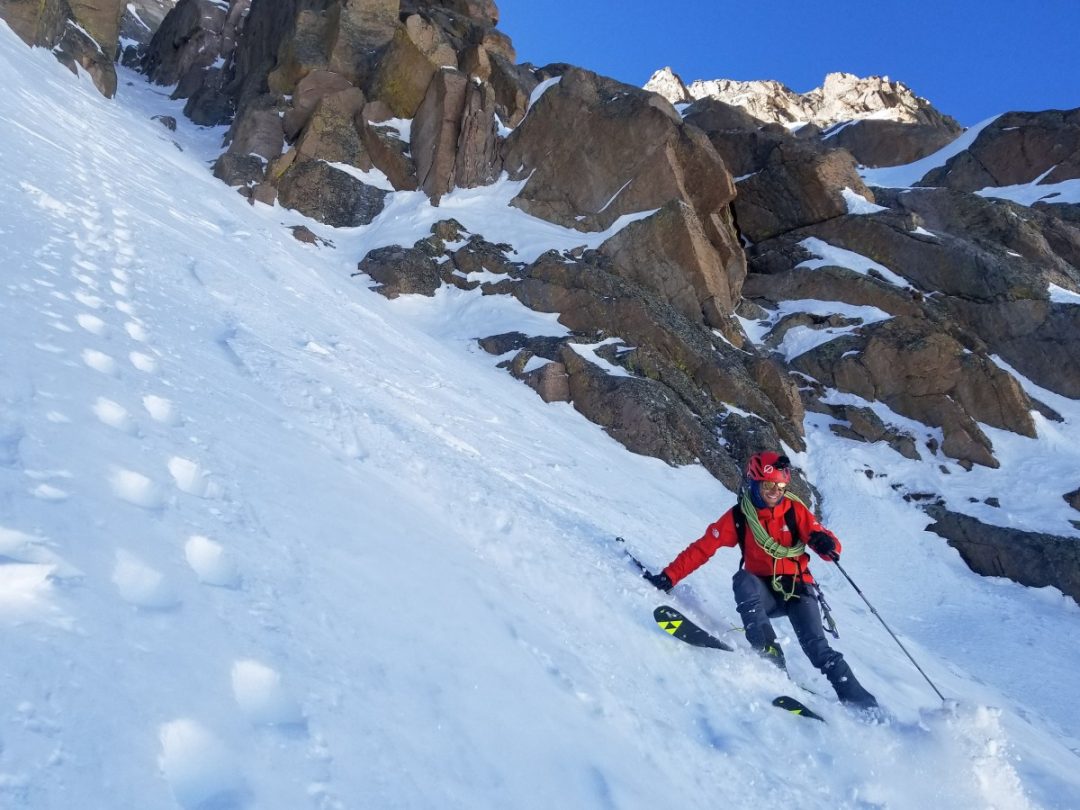
Leven is all smiles during a winter descent of the Notch Couloir on Colorado’s Longs Peak. Photo: Josh Jesperson.
During our conversation, Leven got me thinking about all these things. He explained that ski mountaineering, to have value, might benefit from a standard definition of what it is.
“The only reason money has any value is because we all agree it has value,” said Leven. “I think the same goes for defining ski mountaineering if everyone could pretty much come to a consensus on what ski mountaineering is, and, of course, that may or may not change over time. Then Leven quoted the Supreme Court Justice from 1964.
Ski mountaineering, as a pursuit, has evolved. Like any mountain focused obsession, the gear, now, is better. Advances in technology foster real leaps in technical proficiency. Not to mention the ancillary advances in training, nutrition, and mental preparation (positive self talk anybody?. Way back when, a line may have been off-limits, or hair raising, in part, due to lackluster skis, boots, and bindings. Wider dimensions, out-on-a-limb camber profiles, material science, better weather forecasting, and, of course, smaller cameras brought some of those lines into submission.
But a scary consequential line does not, categorically, make it ski mountaineering.

A headlamped Brody Leven at the start of Ham & Eggs on the Moose’s Tooth in the mighty Ruth Gorge. Photo: Forest Woodward.
“I think the people skiing the Y-Not Couloir here in the Wasatch now probably feel the same way as when I skied it, something like 15 years ago, which is ‘wow, I’m ski mountaineering,'” Leven said. “It is steep. There are no fall zones; there is a mandatory 20 foot repel in the middle of it. It is exposed to avalanche debris and or avalanches. Those components are still there now. And if that is the gnarliest thing you have ever skied, you probably feel like that is ski mountaineering. When we get into backcountry skiing, the barometer for what we call ski mountaineering is pretty much our most challenging ski descent.”
In Leven’s mind, there was a relatively concrete understanding of what is and what is not ski mountaineering. After including the mandatory sharp pointy things, the key components were the rappelling, sustained continuous no-fall skiing, and absolute geographic isolation. Alaska Range type isolation is not part of the calculus in places like the Wasatch, where 80% of Utah’s population spreads to the west of the range.
“There’s a lot of components that I think need to be added together to create proper ski mountaineering, and there is very little terrain here [in the Wasatch] that has all of those components combined,” Leven said. “Instead, you can ski terrain with individual components, where you can hone those skills.”
Leven brought up a humbling conversation he once had with late Swedish ski mountaineer Andreas Fransson. The Swede, the first to ski the South Face of Denali, was the unofficial godfather of the scene.
“I remember Andreas Frasson, once we were talking about ski mountaineering, and I was trying to establish some credibility with him,” recalled Leven. “He’s like, ‘yeah, I’ve seen some of the steep billy-goating that you’ve done.’ And I was like, ‘Oh, that’s not ski mountaineering.'”
I fall into the archetype of a skier calling their boldest descents ski mountaineering. I can see claiming there were components of ski mountaineering in what I had skied, but, what I had skied, was not, in total, ski mountaineering. I thought I knew ski mountaineering when I experienced it, or at least saw it. But maybe not. I could have been billy-goating.

Hilaree Nelson shatters glass ceilings – just another day in the life on Lhotse. Photo: Nick Kalisz.
Telluride based skier Hilaree Nelson, as much as anybody, has a unique perspective on ski culture. As a young woman in the mid-90s, she drank from the ancestral holy grail of ski mountaineering – the accessible alpine mecca of Chamonix, France.
“For me, it was probably when I first moved to Chamonix,” said Nelson when asked when she first sensed she wasn’t exactly backcountry skiing. “I mean, it’s still lift access, but I was like, ‘Dude, this is not backcountry skiing.’ I’m leaving my house with ice axes, and crampons and I don’t even know what a glacier is, but I’m trying to navigate and hoping I don’t kill myself. Maybe that was my first time when I was like, ‘whoa, this seems a little more intense than just backcountry skiing in Colorado.”
In places like Chamonix, the idea of nailing down the “golden age” of ski-line progression can be tricky. For those, like Nelson, making a pilgrimage and being surrounded by personalities and bold descents, every era can likely feel “golden”. It was a time not long after the commercial release of a Dynafit branded tech binding. So, if not the golden era, it was pretty damn close. Nelson was there with her plastic climbing skins and nascent headfirst dive into developing proficiency with complex rope systems. All while skiing into an ever steepening and consequential maw. She lived and thrived in that Cham scene for five years, a time when she would periodically return to the States or hit the more extensive ranges of lore on ski expeditions.
“When I came back to the States, for me, it basically became ‘I’m home, I’m going backcountry skiing,'” said Nelson. “If I’m leaving to go on an expedition, then I’m going ski mountaineering. At that time, it was really black and white. And it still kind of is. I do think, there are some things in Telluride, for example, that kind of saddle both sides of the fence. Because, even though I take the chairlift up, and then I ski down and then tour back up in five hours, I’m still using ropes. It’s a little bump above backcountry skiing, but I don’t know if it is quite ski mountaineering.”
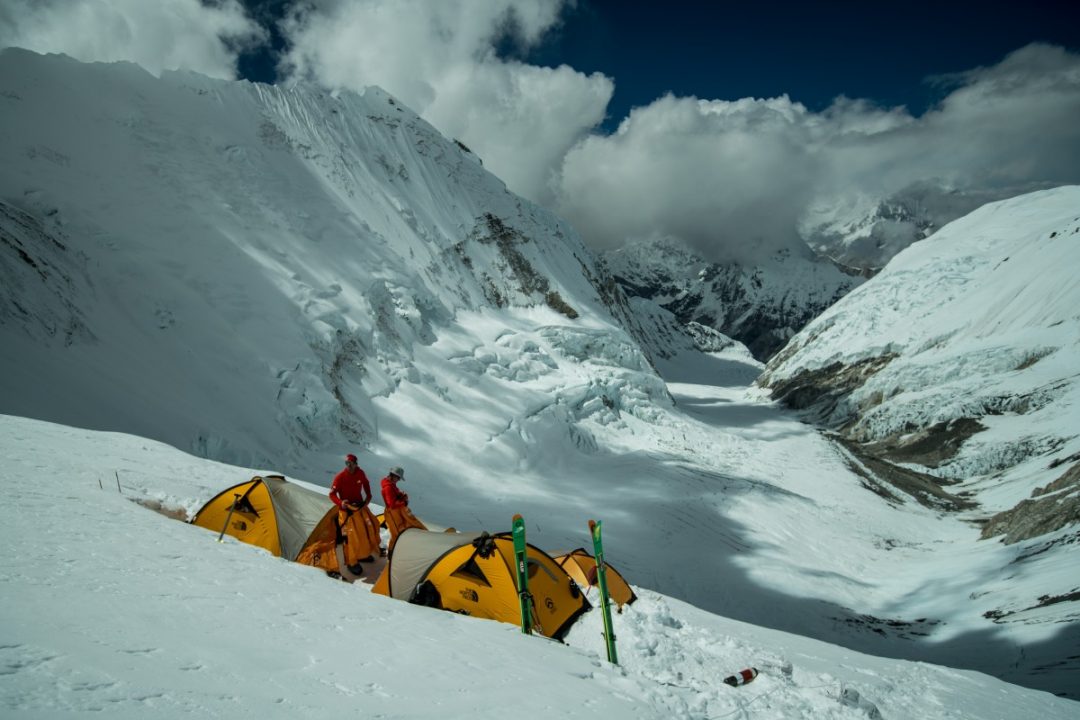
Tent living, high altitude- Jim Morrison and Hilaree Nelson in the throne room: this is ski mountaineering. Photo: Dutch Simpson.
In an email exchange before we spoke, Nelson laid down two criteria for a ski descent to be considered ski mountaineering: multi-day (sleeping outside) and the requisite gear – ropes, harnesses, crampons and ice axes. She did, however, add this: “I can sometimes be swayed on the multi-day thing as there are descents you can get into in the Alps and even in Telluride that feels like ski mountaineering in a single day, but the second thing is a must.”
Traditionally, humans default to binary thinking, a yes or no view of the World. It’s simpler, and it helps us make decisions. But, it also neglects the complexities of the real World while muddling along in it. No matter how superficial it remains in the cosmos, and we recognize it is superficial (but we love it), skiing falls into the binary trap. And by extension, so does this trip into defining ski mountaineering. Arriving at an answer here is slippery.
Even though we may see the same thing, we may differ in describing what we are seeing: a threshold test paradox. As I spoke to Nelson, I could sense she fully understood what ski mountaineering is in practice. After all, she and Jim Morrison had skied the Lhotse Couloir and Face in 2018. Back then, I interviewed the two skier/climbers who documented that epic, Dutch Simpson and Nick Kalisz, for another story, so I understood – from my armchair – what that climb-ski entailed: it was ski mountaineering.
“You have got to be out there; you have got to be committed,” Nelson said of ski mountaineering. “This is something you have to work a lot harder for.”
Nelson’s ski career straddles that past in Chamonix and the present future in Lhotse. Like Leven, however, she recognizes that perceptions and definitions are not static. She reflected that some descents from her past might no longer qualify as ski mountaineering, citing the Cosmiques Couloir on the Aiguille Du Midi, as one example. The tram accessed line involves a rappel entrance, no fall skiing, and a crevassed glacier as the line transitions to an apron.
“That feels like ski mountaineering to me, but the only problem with that is that now, when you go to do that, Cosmiques is probably a mogul run because it’s so traveled. Obviously, a mogul run is not ski mountaineering. It’s a fine line because that’s my foundation for how I learned to be a ski mountaineer. So it’s tough, and I don’t want to take that away and say it’s not anymore. But also, I think, to be considered ski mountaineering, there’s an element of remoteness, an element of solitude. You’re not racing 40 people to get to it first.”
For years, the climbing world has periodically devolved into literal shouting matches, and most recently, online scrums, in which style debates rage. Recently, two British climbers snagged the first ascent of Nepal’s north pillar of Tengkangpoche. The digerati all agreed this was a long sought after ascent. The consensus ended there. The debate began after a not so detailed Instagram post from one of the climbers and a climbing journalist’s attention-grabbing headline. The upside of all those electrons hastily bouncing from platform to platform -half-glass-full thinking here – was a bit more clarity about style and alpinism. From what I could gather, Colin Haley was one voice of reason that stood out amidst the din.
The point here is this: Haley, a storied alpinist, is also a ski mountaineer. He is also fastidious about how he climbs: he’s a Postdoc in style. As I was thinking about this series of stories, Haley was one of the first potential resources I reached out to earlier this fall. In trying to get some clarity on ski mountaineering as a discipline – Haley delivered.
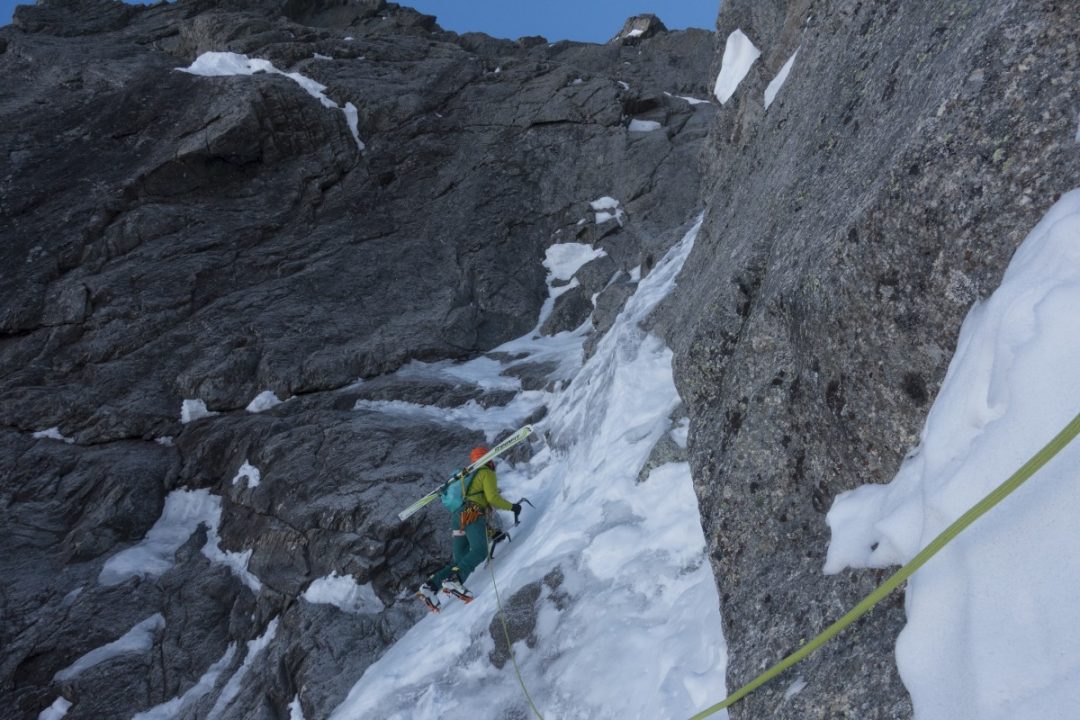
Colin Haley on the ascent’s crux, working towards the descent, on the Dolent-Traverse. Photo: Dave Searle.
“To me, it means skiing, but to the top, or off the top, of a significant mountain. Whereas backcountry skiing, I think of as human-powered, no lifts, but not necessarily in high alpine terrain. Ski mountaineering or ski alpinism means climbing a mountain with skis as your main tool,” said Haley, “whether for the ascent, or for the descent, or both.” This was Haley’s board brushstroke, his intellectual warm-up.
Haley qualified his following statement not so much as a blanket definition but as a way of clarifying some of the misconceptions about comparing ski mountaineering and backcountry skiing. “A way to explain the difference to people is if the thing you’re skiing would be an appealing mountaineering objective in the middle of summer, or a mountain that people would want to go climb in the middle of summer, it might be ski mountaineering,” said Haley. “If your ski outing is covering terrain that in the summer would just be hiking, or just a bushwhack, or a chossy, dry gully, then it’s probably not ski mountaineering, even if people make rappels when skiing it in mid-winter. If you go ski off Mount Hood, that’s something that people would want to climb in the middle of the summer as a mountaineering objective in and of itself. But most backcountry ski tours that people do, if you went to do the same itinerary in the middle of summer, it would just be a horrible bushwhack hike.”
When not visiting his childhood home near Seattle or linking summits in Patagonia, Haley often climbs and skis in Chamonix. He acknowledges that skiing lines on the North of the Midi are impressive, but it is disqualified from the ski mountaineering umbrella since it’s lift access. “It’s dream skiing, for sure,” said Haley. “But I guess it’s kind of the equivalent of sport climbing, in that it can be very impressive from the perspective of the pure sport of steep skiing, but there’s not really any adventure involved.”
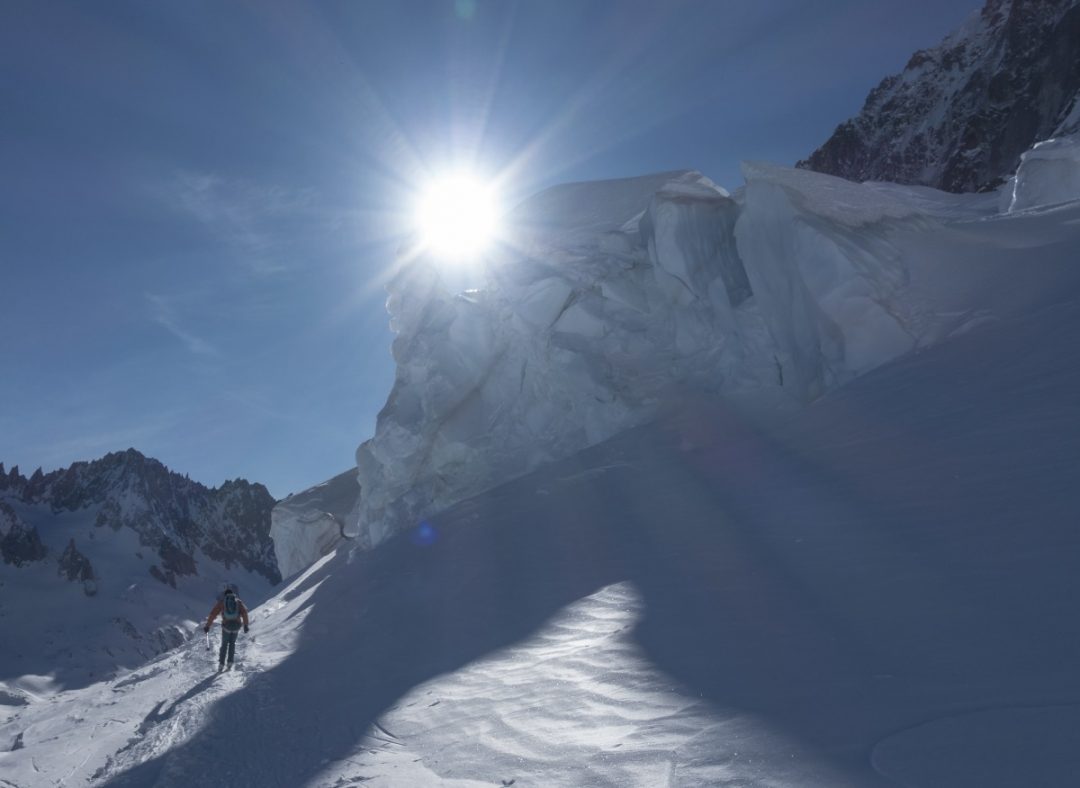
Haley during the Dolent-Traverse, where all the ski mountaineering elements presented themselves. Photo: Dave Searle.
The gears turned as Haley ruminated on an interaction he, too, had with the Swede, Fransson. The skiing Fransson engaged with was no joke. Like Haley, he spent time thinking about his craft and the actual practice of it in the field.
“Fransson mentioned something to me years ago, and I hadn’t really thought about it much before that, but it is very true. He said that you could only really judge a steep skiing descent if you see a video of it,” said Haley. “Because the thing is, you don’t have to be that good to get down something with skis on your feet. When people get in over their heads, they end up doing a ton of sidestepping, or they make a bunch of rappels, or they ski on belay, etc. If there’s a ski line that someone descends in five hours with tons of sidestepping, and a few rappels, and someone else descends the same line, properly skiing the whole thing in 25 minutes, they’re not really comparable achievements, even if both people are like, ‘Oh, yeah, I just skied the so and so.'”
To me, the best ski mountaineering is when your skis make you more efficient, not less efficient – when the skiing isn’t just a party trick to be able to say that you skied something. It’s when skis make the whole experience drastically more fun, or drastically faster, than if you didn’t have skis. – Colin Haley
Haley went on to provide more clarity on how he perceives proper ski mountaineering. (This is also a reminder that Haley is one of the world’s most proficient alpinists. When he refers to downclimbing terrain faster than some can descend on skis – it’s true.)
“To me, the best ski mountaineering is when your skis make you more efficient, not less efficient – when the skiing isn’t just a party trick to be able to say that you skied something. It’s when skis make the whole experience drastically more fun, or drastically faster, than if you didn’t have skis. For example, I’ve skied off the summit of Denali something like five or six times, down various routes back to the 14 camp. Carrying skis to the top is more work and slower, but every time it was so worthwhile, because the descent back to 14 camp was so drastically faster and more fun than making the same descent on foot.
“By contrast, I’ll share a different story from Aiguille Verte in Chamonix. Aiguille Verte is one of my favorite peaks in Chamonix. I’ve climbed it many times and skied off of it a few times. The last time I climbed it, I skied to the base of the Couturier Couloir, then switched to crampons and climbed to the summit. I planned to descend the Whymper Couloir, which I have skied before, but the spring snow was re-frozen, hard, and nasty. So, rather than putting on my skis, I just started down-climbing the Whymper Couloir in my crampons.
“About halfway down the Whymper I overtook a couple guys who were ‘skiing’ and quickly left them far behind me. Because of the crappy, refrozen snow, they were doing a lot of side-slipping and side-stepping, and I was downclimbing about three times faster than they were ‘skiing.’ When I got to the bergschrund the snow had already softened down there, so I clicked into my bindings, and enjoyed great spring skiing down the Talèfre Glacier. In good snow conditions, I can, for sure, ski the Whymper Couloir faster than I can downclimb it, but at that moment skis just weren’t the best tool for the job – in terms of either speed or fun. The most appealing ski mountaineering objectives are ones where a party without skis would have no chance at all to keep up with a party that has skis, at least for the descent, if not for the whole trip.”
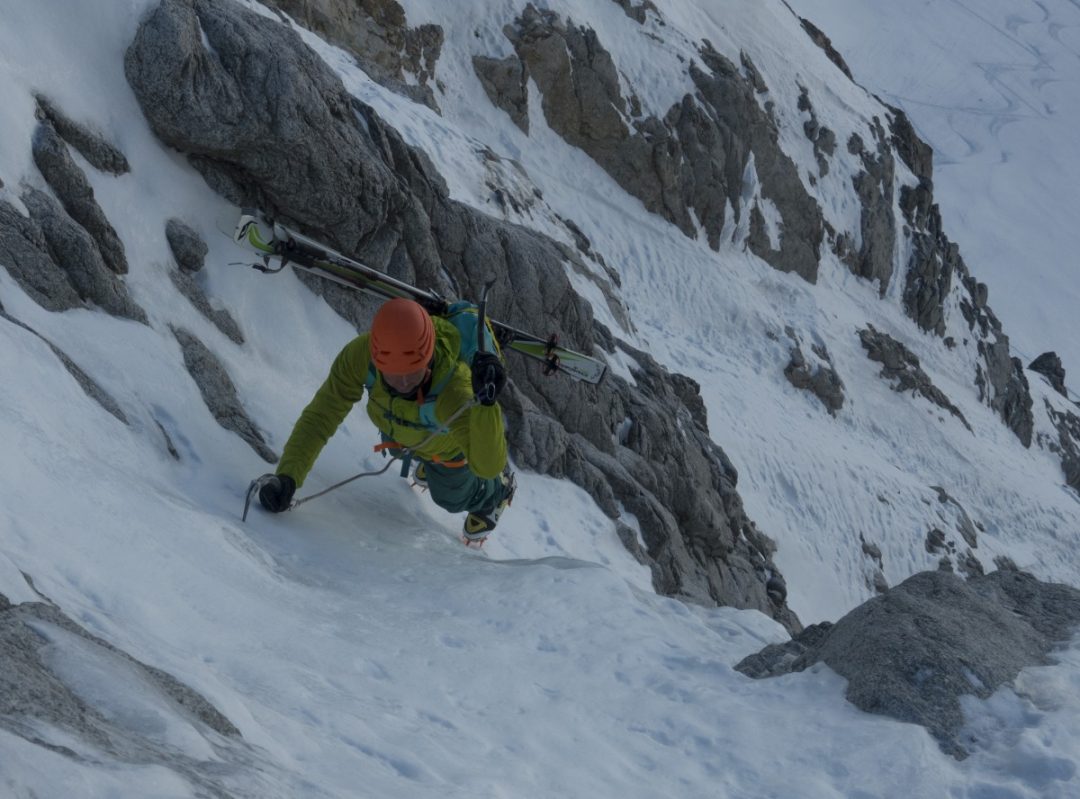
Three points of contact for Haley where he finds himself at home: technical ascents with committing ski lines on the descent. Photo: Dave Searle.
Athletes like Haley think about and execute their mountain craft within the context of a strict code. As for skiing, Haley considers the style of descent as critical to how one represents their potential achievement when claiming ski descents.
“I have thought for a long time that if you want to call it a true, pure ski descent, you are allowed to wear a harness, and you’re allowed to bring a rope,” said Haley. “But the rope, if it comes out of your backpack, then it’s no longer a pure ski descent. And if your ice axe or crampons come out of your backpack, it’s no longer a pure ski descent.”
I touched upon the Supreme Court right from the start. And it circles back right here to the high court with the concept of strict constructivism. Meaning, the definition of ski mountaineering becomes relatively narrow in this context.
Nelson, during our conversation, brought up a line she skied in 2017 with Morrisson and Chris Figenshau. The trio climbed and skied Papsura in the India Himalaya, a 6,461m peak. Theirs was the first ski descent. She referenced this climb and ski while discussing her Lhotse experience and style. “Lhotse is a really good example; what was our style on that?” is how Nelson opened up her thoughts.
Before detailing Papsura, she said she and Morrison had been privately critical of polish ski mountaineer Andrzej Bargiel’s ski of K2.
“He sideslipped and downclimbed, and ice-axed,” she said. “By no means am I trying to detract from the absolute insanity of what he did on K2. But we are both like, ‘is it really a ski descent or is it descending on skis?'”
Nelson then reflected on her Papsura descent. “It has almost a 3000-foot face to it, and we were the first people to, and I’ll be the first person to put “ski” in quotations,” she said. “We descended that mountain on skis. I sidestepped the entire thing with one ski pole and one ice axe, terrified. And I’m still proud of it. I’m like, ‘wow, we frickin’ got down that thing, and nobody died.’ I had my skis on, and I descended on skis. But, I’ll never say that I skied it.”
She then pivoted to bring us back to Lhoste.
“I’m still caught up on the fact that at almost 27,000 feet, we put oxygen on, so we didn’t do it without Os. But we skied it. We made turns; we never took our skis off, we skied through the choke, we skied right off the summit, we made turns, we didn’t sideslip any of it. We skied it, but we used oxygen. So I think looking back on all that stuff – I’m getting older, you know, two and a half kids – I’m a little easier on myself about style. Jim has helped me to get to this point because this is definitely how he sees it. Is that you set the bar. You put the bar there for whatever it is. On Papsura, we sidestep the whole thing. We descended on skis, but the bar is there. I can’t wait for somebody to come back and do it better. Do it in a better style.”
A few minutes later, Nelson explained that her thoughts about Bargiel’s descent of K2 had evolved. Initially, she had only seen “bit and clips” of Bargiel on the mountain. Then she saw the full-blown film of his solo, oxygenless, climb and ski nearly a year later.
Nelson said, “when the film came out, I realized he really did ski, he made turns, he was the first to do it and set a high bar. That’s frickin’ incredible.”
Both Nelson and Leven made clear during their interviews that adventure is personal. We may debate the merits of style, and we may compartmentalize achievements, and that may have its place. But skiing, be it ski touring, backcountry skiing or ski mountaineering, is personal. Hopefully, it is also about personal growth.
“Anyone can go outside and have the hardest day of their life,” said Leven.
“Anyone, and I love that concept. And those hardest days can be anything from taking two steps outside to doing the hardest thing anyone’s ever done, whatever. And I think that is what makes the outdoors so appealing, because it is like the most naturally progressive environment in which you can take one step up from your previous hardest thing.”
Have we gotten any closure to defining what is ski mountaineering and what is not backcountry skiing?
Maybe. We’ve certainly presented some ideas. The bottom line of all this is to make sure we get out and explore.
“Take a risk, say yes to something you’re uncomfortable saying yes to,” is how Nelson speaks to audiences about adventure. “So that’s how I typically frame it. Because a lot of what I talk about is how important it is to step outside of your box. How important it is for your mental health, for your ability to grow, to be a lifelong learner – it is to take risks, to not be afraid to like fail, and then learn something from it and try it again and say ‘yes’ to things, don’t be closed off. All of that is an adventure to that person.”
Jason Albert comes to WildSnow from Bend, Oregon. After growing up on the East Coast, he migrated from Montana to Colorado and settled in Oregon. Simple pleasures are quiet and long days touring. His gray hair might stem from his first Grand Traverse in 2000 when rented leather boots and 210cm skis were not the speed weapons he had hoped for. Jason survived the transition from free-heel kool-aid drinker to faster and lighter (think AT), and safer, are better.

